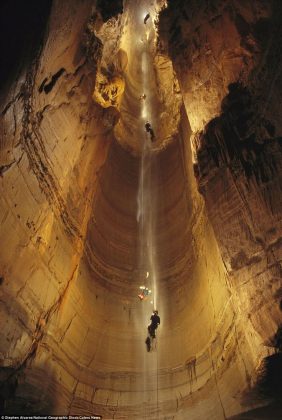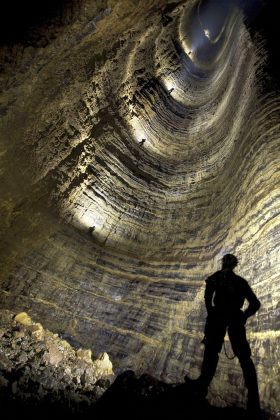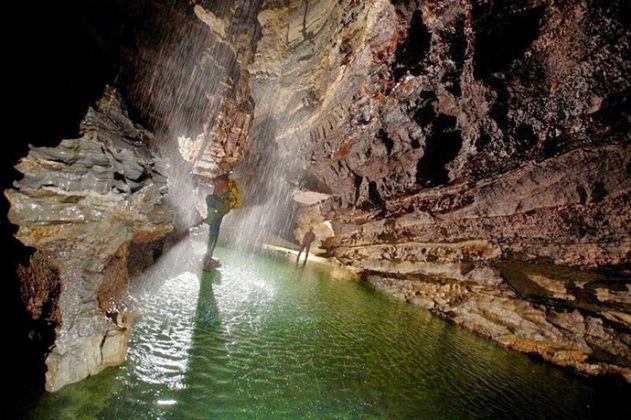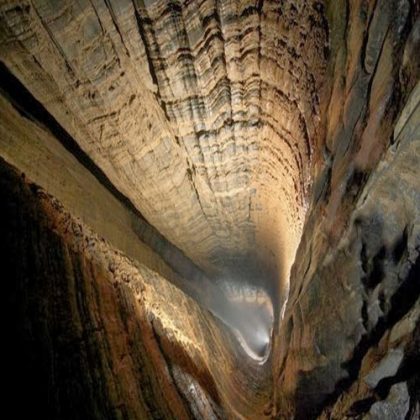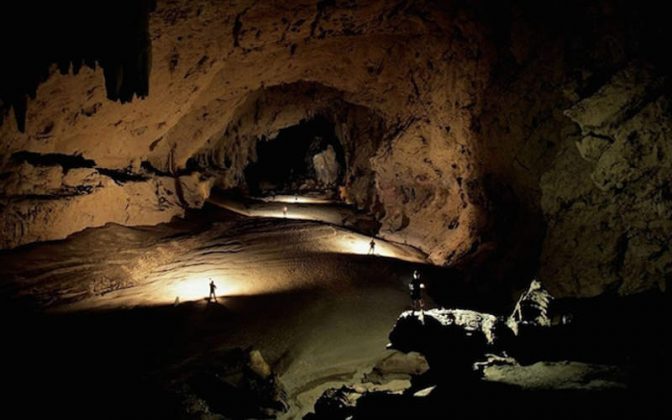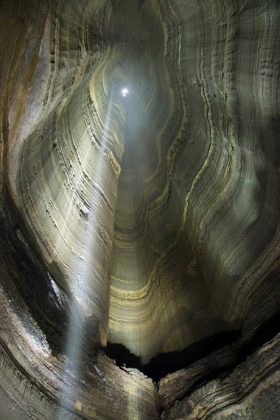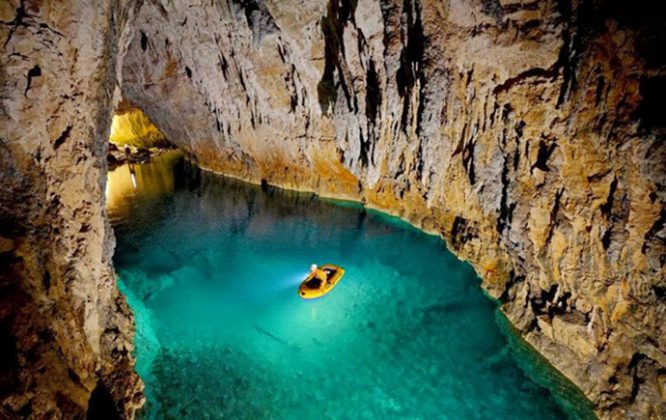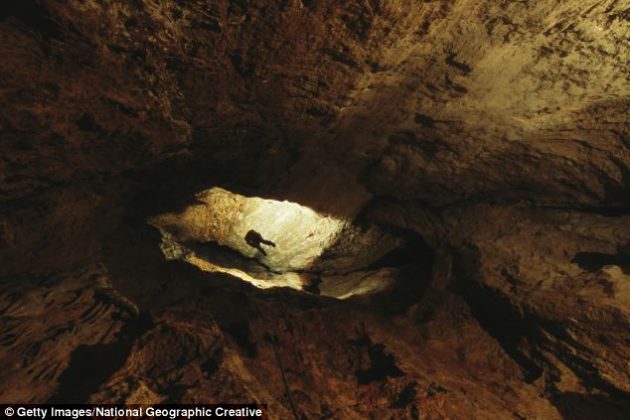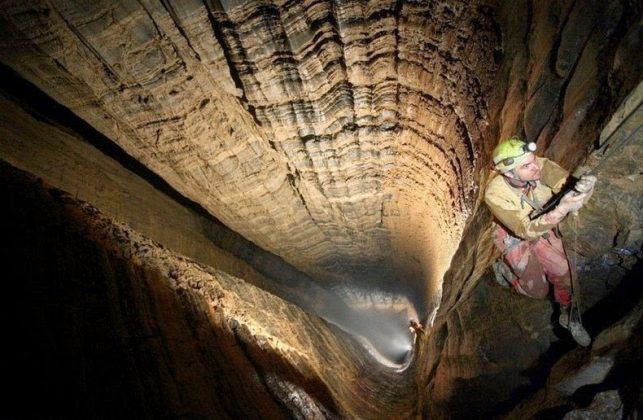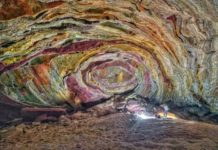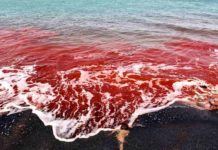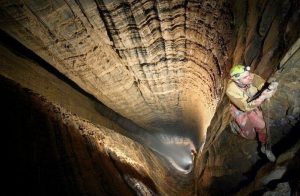
Krubera Cave is the deepest known cave on Earth. It is located in the Arabika Massif of the Gagra Range of the Western Caucasus, in the Gagra district of Abkhazia, a breakaway region of Georgia.
The difference in elevation of the cave’s entrance and its deepest explored point is 2,197 ± 20 metres (7,208 ± 66 ft). It became the deepest-known cave in the world in 2001 when the expedition of the Ukrainian Speleological Association reached a depth of 1,710 m (5,610 ft) which exceeded the depth of the previous deepest known cave, Lamprechtsofen, in the Austrian Alps, by 80 m. In 2004, for the first time in the history of speleology, the Ukrainian Speleological Association expedition reached a depth greater than 2,000 m, and explored the cave to −2,080 m (−6,824 ft). Ukrainian diver Gennadiy Samokhin extended the cave by diving in the terminal sump to 46 m depth in 2007 and then to 52 m in 2012, setting successive world records of 2,191 m and 2,197 m respectively. Krubera remains the only known cave on Earth deeper than 2,000 metres.
Location and background

The Arabika Massif, the home of Krubera (Voronya) Cave, is one of the largest high-mountain limestone karst massifs in the Western Caucasus. It is composed of Lower Cretaceous and Upper Jurassic limestones that dip continuously southwest to the Black Sea and plunge below the modern sea level.
To the northwest, north, northeast, and east, Arabika is bordered by the deeply incised canyons of Sandripsh, Kutushara, Gega and Bzyb rivers. The Bzyb River separates Arabika from the adjacent Bzybsky Massif, another outstanding karst area with many deep caves, including the Snezhnaja-Mezhonogo-Iljuzia System (−1,753 m or −5,751 ft) and Pantjukhina Cave (−1,508 m or −4,948 ft). To the southwest, Arabika borders the Black Sea.
The Arabika Massif has a prominent high central sector with elevations above the tree line at ~1,800–1,900 m (5,900–6,200 ft). This is an area of classical glaciokarstic landscape, with numerous glacial trough valleys and cirques, with ridges and peaks between them. The bottoms of trough valleys and karst fields lie at elevations of 2,000–2,350 m (6,560–7,710 ft), and ridges and peaks rise to 2,500–2,700 m (8,200–8,900 ft). The highest peak is the Peak of Speleologists (2,705 m (8,875 ft)) but the dominant summit is a typical pyramidal horn of the Arabika Mount (2,695 m (8,842 ft)). Some middle- to low-altitude ridges covered with forest lie between the central sector and the Black Sea. A plateau-like middle-altitude outlier of the massif in its south sector is Mamzdyshkha, with part of the plateau slightly emerging above the tree line.
Among several hundred caves known in the Arabika Massif, fifteen have been explored deeper than 400 m and five deeper than 1,000 m (shown in Figure 1).
Krubera Cave is located at 2,256 m above sea level in the Ortobalagan Valley, a perfectly shaped, relatively shallow, glacial trough of the sub-Caucasian stretch, which holds the advanced position in the Arabika’s central sector relative to the seashore. Since 1980, Ukrainian cavers have been undertaking systematic efforts in exploring deep caves in the Ortobalagan Valley, resulting in exploration of the Krubera Cave to its current depth and of the Arabikskaja System to depth of −1,110 m (−3,640 ft). The latter consists of Kuybushevskaya Cave (also spelled as Kujbyshevskaja; −1,110 m) and Genrikhova Bezdna Cave (−965 m to the junction with Kujbyshevskaja). Another deep cave in the valley, located in its very upper part and explored by Moldavian and Ukrainian cavers is Berchilskaya Cave, 500 m (1,600 ft) deep. All large caves of the Ortobalagan Valley likely belong to a single hydrological system, connected to large springs at the Black Sea shore. The direct physical connection of Krubera Cave with the Arabikaskaja System is a sound possibility, although not yet physically realized.
Geology

The Ortobalagan Valley extends along the crest of the Berchil’sky anticline, which gently dips northwest. The cave entrances are aligned along the anticlinal crest but the caves are controlled by longitudinal, transverse, and oblique fractures and faults and comprise complex winding patterns in the plan view, remaining largely within and near the anticlinal crest zone. The caves are predominantly combinations of vadose shafts and steep meandering passages, although in places they cut apparently old fossil passages at different levels (e.g., at −2,100–2,040 m (−6,890–6,690 ft) in Kujbyshevskaja and Krubera caves, −1,200–1,240 m (−3,940–4,070 ft) and −980–1,150 m (−3,220–3,770 ft) in the non-Kujbyshevskaja branch of Krubera Cave, etc.). The deep parts of Krubera display a more pervasive conduit pattern with a mixture of phreatic morphology, characteristic of the zone of high-gradient floods, which can be up to 400 m above the low-flow water table, and vadose downcutting elements that are observed even below the water table.
The core part of the Arabika Massif is composed of the Upper Jurassic succession resting on the Bajocian Porphyritic Series, which includes sandstones, clays and conglomerates at the top, and tuff, tuff sandstones, conglomerates and breccia, porphyry and lava. The Porphyritic series forms the non-karstic basement of Arabika, which is exposed only on the northern and eastern outskirts, locally in the bottoms of the Kutushara and Gega River valleys. In the central part of Arabika the Cretaceous cover (Valanginian and Hauterivian limestones, marls and sandstones) is retained only in a few ridges and peaks, but it lies intact through the low-altitude ridges to the south-west of the central part. There the Cretaceous succession includes Barremian and Aptian–Cenomanian limestones and marly limestones with abundant concretions of black chert.
The Upper Jurassic succession begins with thin-bedded Kimmeridgian–Oxfordian cherty limestones, marls, sandstones and clays, which are identified in the lower part of Krubera Cave. Above lies the thick Tithonian succession of thick-bedded limestones with marly and sandy varieties. Sandy limestones are particularly abundant through the upper 1,000 m sections of deep caves of the Ortobalagan Valley.
The tectonic structure of Arabika is dominated by the axis of the large sub-Caucasian anticline (oriented NW–SE), with the gently dipping southwestern mega-flank, complicated by several low-order folds, and steeply dipping northeastern flank (Figure 3). The axis of the anticline roughly coincides with the ridge bordering the Gelgeluk Valley to the north. Located on the southwestern flank of the major anticline is another large one (Berchil’sky), in which the crest is breached by the Ortobalagan Valley. There are several smaller sub-parallel anticlines and synclines farther southwest, between the Berchil’ Ridge and the coast.
The plicative dislocation structure of the massif is severely complicated by faults, with the fault-block structure strongly controlling both cave development and groundwater flow. Major faults of the sub-Caucasian orientation delineate several large elongated blocks that experienced uplift with different rates during Pliocene and Pleistocene. This had a pronounced effect on the development of deep groundwater circulation and of Krubera Cave in particular. Both longitudinal and transverse faults and related fracture zones play a role in guiding groundwater flow; the latter guide flow across the strike of major plicative dislocations, from the central sector toward the Black Sea.
Hydrogeology
Major on-shore karst springs with individual average discharges of 1 to 2.5 m3/s (35 to 88 cu ft/s) are located at altitudes ranging from 1 m (3.3 ft) (Reproa Spring) to 540 m (1,770 ft) (Gega waterfall). Two of them are located in the shore area; these are Reproa (average discharge 2.5 m3/s or 88 cu ft/s; altitude 1 m or 3 ft 3 in above sea level) and Kholodnaja Rechka (1.2 m3/s or 42 cu ft/s; 50 m or 160 ft a.s.l.). Two more major springs are located in the river canyons bordering Arabika to the east: Goluboe Ozero in the Bzyb canyon (2.5 m3/s or 88 cu ft/s; 90 m or 300 ft a.s.l.) and Gega waterfall in the Gega canyon (1 m3/s or 35 cu ft/s; 540 m or 1,770 ft a.s.l.). There are also several smaller springs in the Gagra town.
Some boreholes located along the shore of the Black Sea yield karstic groundwater from depths of 40–280 m below sea level. Other much deeper boreholes tapped low-salinity karstic waters at depths of 500 and 1,750 m in the Khashupse Valley near Tsandripsh and 2,250 m near Gagra. This suggests the existence of a deep karst system and vigorous karst groundwater circulation at depth.
Submarine springs are known in the Arabika area, emerging from the floor of the Black Sea in front of the massif. Shallow springs at depths of 5–7 m can be reached by free dive near Tsandripsh. Tamaz Kiknadze (1979) reported submarine springs near the eastern part of Gagra at depth of 25–30 m and Buachidze and Meliva (1967) revealed submarine discharge at depths up to −400 m by hydrochemical profiling. Recently an outstanding feature of the sea floor topography near Arabika has been revealed from a digital bathymetric map that combines depth soundings and high-resolution marine gravity data. This is a huge submarine depression in front of the Zhovekvara River mouth, which has dimensions of about 5 x 9 km and a maximum depth of about 380 m (1,250 ft). The Arabika Submarine Depression is a closed feature with internal vertical relief of about 120 m (390 ft) (measured from its lowest rim) separated from the abyssal slope by the bar at a depth of about 260 m (850 ft). It has steep northern and northeastern slopes (on the side of the massif) and gentle south and southwestern slopes. Its formation is apparently karstic. Presently this depression seems to be a focus of submarine discharge of the karst systems of Arabika.
The speleological explorations and a series of dye tracing experiments conducted during the 1980s under the coordination of Alexander Klimchouk have radically changed previous notions of the hydrogeology of Arabika, revealed its outstanding speleological perspectives and strongly stimulated further efforts for exploration of deep caves. Tracers injected in the Kujbyshevskaja Cave and the Iljukhina System were detected in the Kholodnaja Rechka and Reproa springs, proving groundwater flow to the south-southwest across major tectonic structures over a distance of 13–16 km as the crow flies (Figure 1). The tracer from Kujbyshevskaja Cave was also detected in a borehole located between these two springs, which yields groundwater from a depth of 200 m (660 ft) below sea level. This has been interpreted as an indication of the connection of the cave with the submarine discharge. The large “Central Karst Hydrologic System”, which encompasses most of the southeastern flank of the Arabika anticline, had been identified in this way. The system became the deepest in the world with its overall vertical range of about 2,500 m (8,200 ft) (measuring to the borehole water-bearing horizon) or even 2,700 m (8,900 ft) (measuring to the deepest reported submarine discharge points).
Another tracer was injected in the Moskovskaja Cave (−970 m) and detected at the Gegsky Vodopad spring, indicating the presence of a karst hydrologic system comprising the northeastern flank of the Arabika anticline (the “Northern System”). No connections have been revealed with yet another major spring, Goluboje Ozero in the Bzyb River canyon, although it apparently drains a large area of the eastern sector of the massif (the hypothetical “Eastern Karst Hydrological System”). It is not clear where Sarma Cave (−1,550 m) drains to, Goluboje Ozero to the southeast or Reproa to the southwest, at the shore.
The results of the dye-tracing tests demonstrated that groundwater flow is not subordinate to the fold structure but is largely controlled by faults that cut across the strike of major folds, and that the large part of the central sector of Arabika is hydraulically connected to the springs along the seashore and with submarine discharge points.
Krubera Cave has an extremely steep profile and reveals a huge thickness of the vadose zone. The lower boundary of the vadose zone (the top of the phreatic zone) is at an elevation of about 110 m (360 ft) at low flow, which suggests a low overall hydraulic gradient of 0.007-0.008. Low-TDS groundwater is tapped by boreholes in the shore area at depths of 40–280, 500, 1,750, and 2,250 m below sea level, which suggests the existence of a deep flow system with vigorous flow. Submarine discharge along the Arabika coast is reported at depths up to ~400 m b.s.l.
It is difficult to interpret these facts in terms of the development of karst systems controlled by contemporary sea level, or within the range of its Pleistocene fluctuations (up to −150 m). In combination with the existence of the Arabika Submarine Depression, all these facts point to the possibility that karst systems in Arabika could have originated in response to the Messinian salinity crisis (5.96–5.33 Ma) when the Black Sea (Eastern Paratethys) could have almost dried up, as did the adjacent Mediterranean, where the dramatic sea level drop of ~1,500 m is well established.
Photos
Note: The above post is reprinted from materials provided by Wikipedia.


